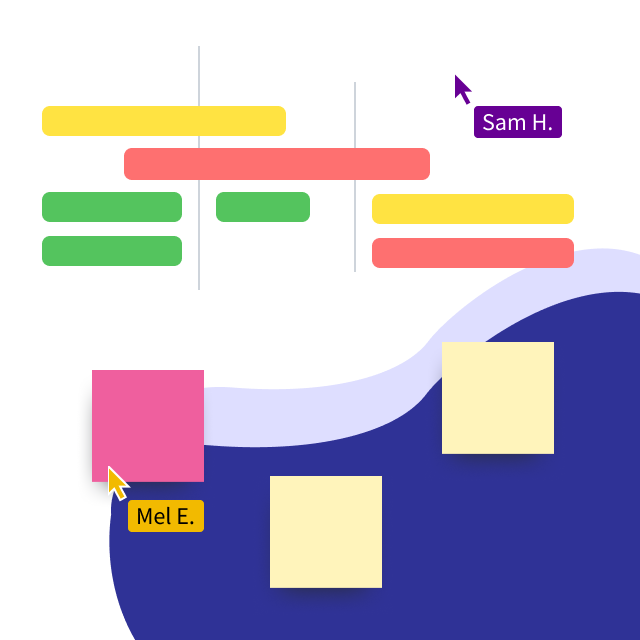
Successful asynchronous planning for Agile teams
Reading time: about 6 min
In today’s highly competitive business environment, teams are expected to develop and ship products faster—and better—than ever before. While, traditionally, Agile teams relied heavily on in-person, synchronous work to get the job done, this approach has its drawbacks.
Synchronous work and communication require in-person and/or real-time communication between two or more people. Whether that’s getting together for a stand-up planning meeting at the office, or jumping on a phone call to hash out new product requirements, synchronous work means team members are always dependent on another person before they can complete work. And that can result in costly delays and lower productivity and output overall.
However, with the rise in remote work and improved technology and collaboration tools, teams are better equipped than ever before to operate asynchronously.
In this article, we’ll cover what asynchronous planning is and how you can use it to accelerate your project pipeline, increase agility, and maximize efficiency from start to ship.
What is asynchronous planning?
Project management and development don’t happen in a vacuum. Agile teams are by nature, cross-functional groups that rely on one another to complete tasks and requirements within their spheres of responsibility throughout the product development lifecycle.
Traditionally, Agile teams have approached product development synchronously—planning products in person, communicating via instant messaging or regular meetings, and completing tasks in bulk phases one after the other. But this keeps the team dependent on each person and stage that comes before and has the potential to slow down development.
Asynchronous planning is a way to get things done with fewer interruptions, greater efficiency, and higher output. Whereas synchronous work is conducted in bulk phases, one after the other, asynchronous planning breaks down those phases into smaller tasks divided among a cross-functional team focused on releasing minimum viable changes as often as possible. This results in more frequent shipping of smaller releases.
3 keys to successful asynchronous planning
Asynchronous planning doesn’t happen overnight. To be successful, you need to build the right foundation.
Asynchronous planning relies on:
Multiplexing
Multiplexing means doing tasks together that reinforce one another for better, faster results. For example, taking notes while having a conversation—while you could do both separately, the two tasks complement each other, leading to better results.
So how does this apply to asynchronous planning?
In an asynchronous work setting, multiplexing is all about batching smaller tasks for a quicker release. This allows you to not only ship faster, but also validate your product, measure success, and adapt to feedback more quickly and nimbly.
Multiplexing through async work also means you can allocate your resources more efficiently because you’re focusing on more tasks on a smaller scale. By reducing your task scope, you can more accurately manage resources and estimate needs compared to larger batches of work.
Communication
Asynchronous communication is crucial for successful asynchronous planning and development. Communicating asynchronously empowers you and your team to work on their own time at their own pace (within a given timeline).
In today’s always-on culture, an immediate response is often expected when it comes to communication. But by adopting an asynchronous approach when possible, team members are able to focus on deep work for longer periods of time and get the work done when they are most productive—whether that’s at 9AM or 3PM or 10PM.
Of course, you need clear standards and expectations in place for the best results. Work with your team to ensure everyone contributes to and supports:
- Robust documentation
- Clear, written procedures
- Boundaries on interruption-free work windows
These best practices will provide the foundation you need for effective asynchronous communication on your team.

Explore Lucidspark's chat feature to enhance communication with your team.
Check it outAction
Asynchronous planning doesn’t entirely eliminate delays. But that shouldn’t stop you and your team from executing and driving forward.
There will be times when a coworker is online and available to answer questions, or when tasks aren’t fully planned. Successful async teams lean towards execution first—you can always revise and adapt from there.
If the priority task is sensitive and you have to wait, pick up smaller or lower priority issues you can knock out in the meantime. By defaulting towards action, async teams keep projects moving forward, rather than wasting time stuck in a holding pattern.
Benefits of asynchronous planning and communication
Asynchronous planning and asynchronous communication have many advantages for both in-person and remote teams, including:
Increased accountability. Defaulting towards action, with more independence on individual tasks puts greater ownership and accountability on team members to deliver. Rather than waiting on other people to get work done, each person can work independently on the time and schedule that works best for them regardless of what others are doing. This increases accountability across the board and helps move everyone towards their goals.
Value-driven meetings. Meetings can be important tools for communication and planning, but they are also your most expensive resource. Prioritizing asynchronous communication frees up time for your team to focus on high-value tasks and only schedule those meetings that are necessary or most valuable. This helps improve the quality of your meetings overall and reduces frustration, boredom, and wasted time for your team.
Better resource management. Fewer meetings and more flexibility mean you and your team can focus on what you do best, saving time and boosting productivity across the board. And by breaking down tasks into smaller assignments, project managers can allocate resources with pinpoint precision and adapt to changing requirements with greater agility.
Reduced waste and optimized productivity. Asynchronous planning gives teams greater agility and autonomy to get work done quickly and efficiently. Asynchronous communication allows everyone to reference messages and documentation on their own time without pressure to respond immediately so they can dig into their assignments when they are most productive without interruption.
How a collaborative work management tool can help
Asynchronous planning requires flexible and dynamic collaboration and work management tools to get the job done. Since asynchronous teams work independently and often remotely, Agile teams need solutions that keep everyone in the loop and ensure nothing falls through the cracks.
When it comes to asynchronous communication, the usual suspects include email, instant messaging, and shared documentation. And while these are important, they are insufficient. To get the most out of your asynchronous communication, you need a solution that is built for dynamic collaboration.
That’s where Lucidspark comes in.
Lucidspark is a virtual whiteboard where teams can work together both in real-time and asynchronously to brainstorm, plan, share ideas, and make decisions with confidence.
From ready-made templates and freehand drawing tools to sticky notes and @mentions, Lucidspark makes it easy to house documentation, outline project roadmaps, and assign and track task ownerships from a single source of truth. Streamline coordination between team members and stay on top of your tasks no matter where you are or when you’re working.
As remote work becomes the norm, more and more teams are adopting an asynchronous work approach. Take your Agile development to the next level with asynchronous planning and communication that drives production, minimizes waste, and frees up more time for employees to engage in deep work that moves the company forward, faster.
Get started today with Lucidspark.

Learn more about Agile methodology and how it can benefit your team.
Read nowAbout Lucidspark
Lucidspark, a cloud-based virtual whiteboard, is a core component of Lucid Software's Visual Collaboration Suite. This cutting-edge digital canvas brings teams together to brainstorm, collaborate, and consolidate collective thinking into actionable next steps—all in real time. Lucid is proud to serve top businesses around the world, including customers such as Google, GE, and NBC Universal, and 99% of the Fortune 500. Lucid partners with industry leaders, including Google, Atlassian, and Microsoft. Since its founding, Lucid has received numerous awards for its products, business, and workplace culture. For more information, visit lucidspark.com.
Related articles
A guide to daily stand-ups [+ course]
Learn how to maximize your daily stand-up meetings with Lucidspark. Includes a free course!
